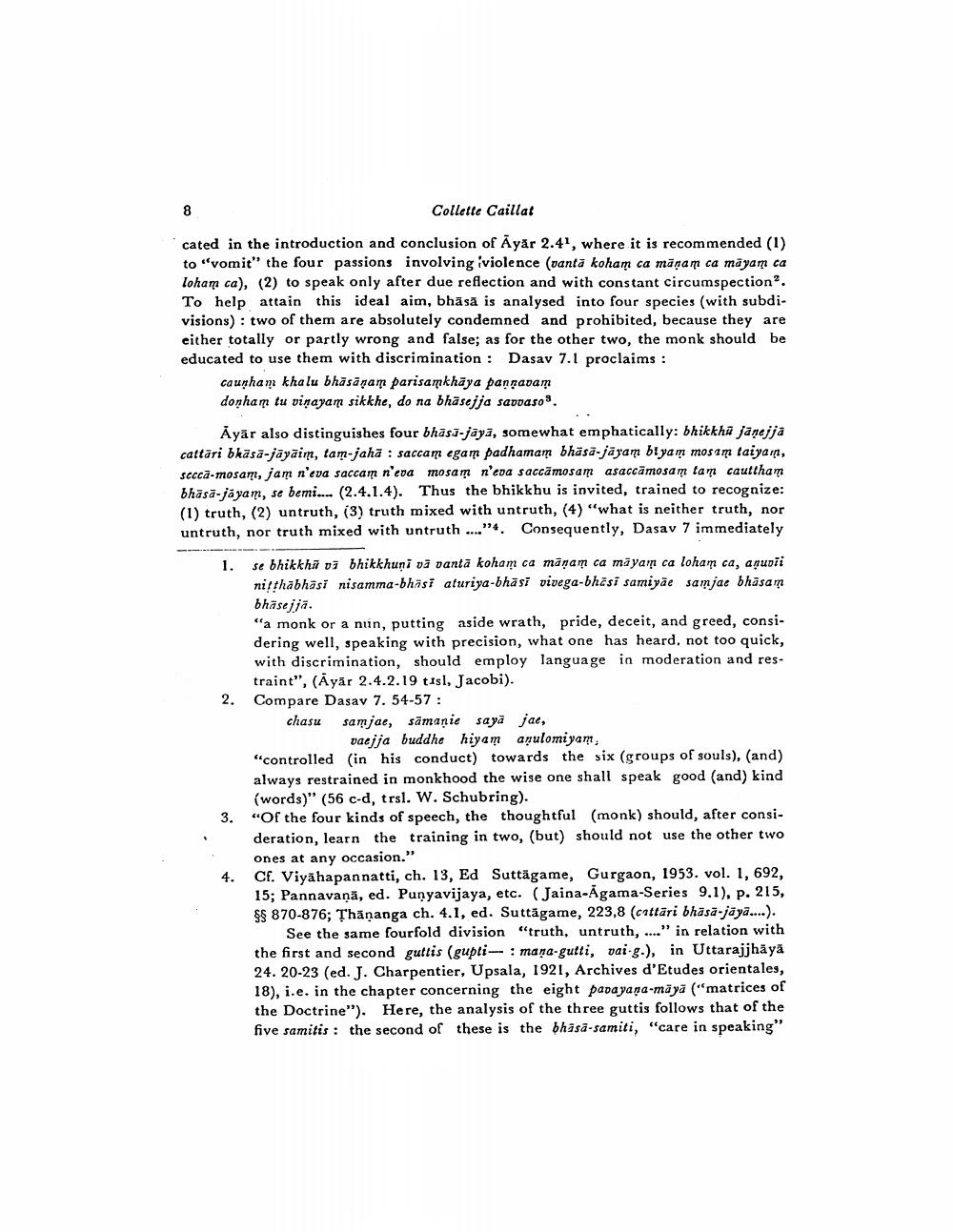Book Title: Rules Concerning Speech In Ayaranga And Dasaveyaliya Suttas Author(s): Collette Caillat Publisher: Collette Caillat View full book textPage 8
________________ Collette Caillat cated in the introduction and conclusion of Āyår 2.4", where it is recommended (1) to vomit" the four passions involving iviolence (vantā koham ca māņam ca mayam ca loham ca), (2) to speak only after due reflection and with constant circumspection? To help attain this ideal aim, bhāsā is analysed into four species (with subdivisions): two of them are absolutely condemned and prohibited, because they are either totally or partly wrong and false; as for the other two, the monk should be educated to use them with discrimination : Dasay 7.1 proclaims : caunham thalu bhāsāņam parisamkhāya pangavam donham tu viņayan sikkhe, do na bhäsejja savaso. Ayar also distinguishes four bhāsi-jāyī, somewhat emphatically: bhikkha janejja cattari bkāsä-jäyāin, tam-jaha : saccam egam padhamam bhäsa-jayam blyam mosam taiyan, sccca-mosam, jam n'eva saccam n'eva mosam neda saccamosam asaccāmosam tam cauttham bhāsa-jayam, se bemi... (2.4.1.4). Thus the bhikkhu is invited, trained to recognize: (1) truth, (2) untruth, (3) truth mixed with untruth, (4) “what is neither truth, nor untruth, nor truth mixed with untruth ....”4. Consequently, Dasav 7 immediately 1. se bhikkha di bhikkhuni di vanta koham ca māņam ca māyam ca loham ca, anubii nitthābhāsi nisamma-bhasi aturiya-bhāsi vivega-bhasi samiyae samjac bhasam bhāsejja. "a monk or a nun, putting aside wrath, pride, deceit, and greed, considering well, speaking with precision, what one has heard, not too quick, with discrimination, should employ language in moderation and res. traint", (Ayār 2.4.2.19 tisl, Jacobi). Compare Dasav 7. 54-57 : chasu samjae, samanie sayā jae, vaejja buddhe hiyam amulomiyam, "controlled (in his conduct) towards the six (groups of souls), (and) always restrained in monkhood the wise one shall speak good (and) kind (words)" (56 c-d, trsl. W. Schubring). “Of the four kinds of speech, the thoughtful (monk) should, after consideration, learn the training in two, (but) should not use the other two ones at any occasion." Cf. Vivāhapannatti, ch. 13, Ed Suttăgame, Gurgaon, 1953. vol. 1, 692, 15; Pannavaņā, ed. Punyavijaya, etc. (Jaina-Agama-Series 9.1), p. 215, $$ 870-876; Thānanga ch. 4.1, ed. Suttägame, 223,8 (cattari bhasa-jaya....). See the same fourfold division "truth, untruth, ..." in relation with the first and second guttis (gupti- : mana-gutti, vai-g.), in Uttarajjhāyā 24. 20-23 (ed. J. Charpentier, Upsala, 1921, Archives d'Etudes orientales, 18), i.e. in the chapter concerning the eight padayana-māya ("matrices of the Doctrine"). Here, the analysis of the three guttis follows that of the five samitis : the second of these is the bhasa-samiti, "care in speaking"Page Navigation
1 ... 6 7 8 9 10 11 12 13 14 15
